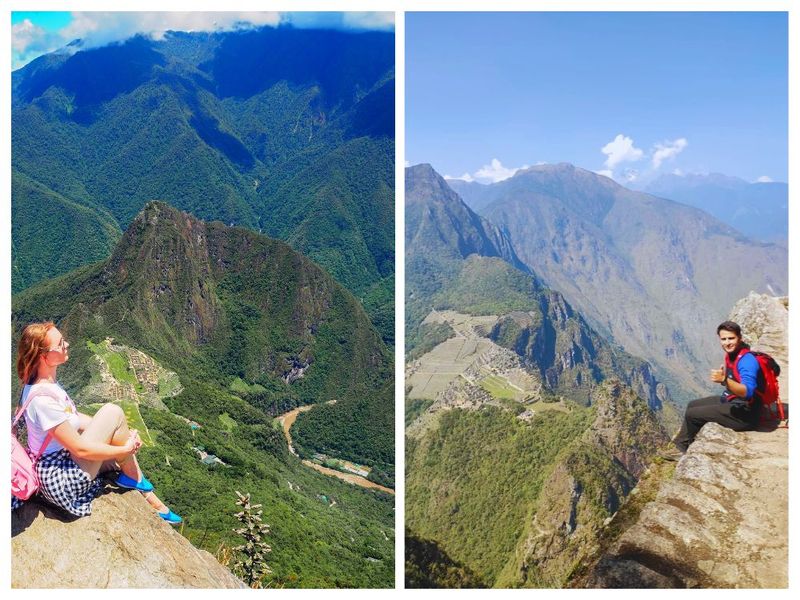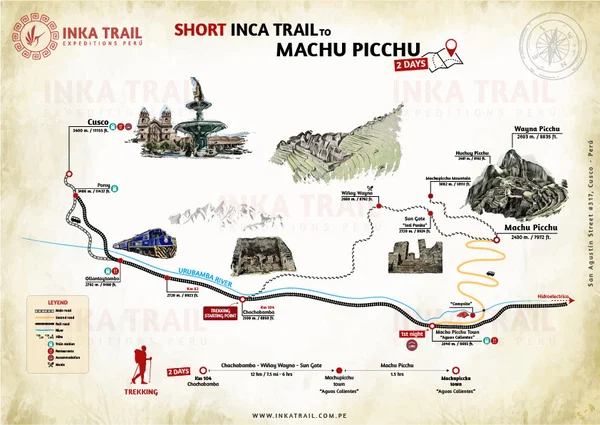Inca trail 2 days to Machupicchu with a sunset experience in Machupicchu on our 1st day “with few people”; taking this adventure day trek we are going to visit the most important Inca site of the famous Inca Trail, Wiñayhuayna “For Ever Young”, midday we are going to arrive the Sun Gate and in the Afternoon a beautiful sunset Machupicchu free time “with few people”.
Early the next morning, we will enjoy the sunrise and a guided tour of Machupicchu. Finally we will be able to climb the incredible Huayna Picchu mountain and enjoy a unique view of Machu Picchu and the Urubamba Valley, only 200 people per day have access.
The Inca Trail to Machu Picchu in Perú is part of an extensive Inca system of trails for more than 23,000 kilometers that integrated the Tahuantinsuyo Empire “The Inka Country” (which means four regions) that covered many South American countries such as Colombia, the west of Brazil, Ecuador, Peru ,Bolivia, to the center of Chile and the north of Argentina. These trails tended to be principally on the coast or in the mountains but in a few cases they reached the tropical edge of the jungle at the Amazon Jungle.
The Inca Trails is called in Quechua “the Inka Language” Qhapaq Ñan - refers to the network of trails) were without a doubt is one of the marvels of Tahuantinsuyo, according to the Peruvian historian, José Antonio del Busto, who explains that the Inca “King” Huayna Capac most increased the network of trails in order to quickly mobilize his army.

Today our trek takes us along the most impressive stretch of the Inca Trail. We'll visit the most beautiful Inca sites; we will be able to see a variety of flora and fauna and take in the fantastic panoramas of the Andes mountains. Covering 16km of the trail, our journey begins in the Sacred Valley; it's way up along the original Inca Trail to another amaizing Inca site named Winay Wayna (forever young); after that, continuing in our way to Machu Picchu via Sun Gate (Inti Punku).
As we make our way to Machu Picchu, we will pass through the lush and verdant cloud forest that covers the mountain and get to see a diversity of plants, flowers, and birds along the way. We may also see some major mammals, such as viscachas (rabbit-like Chinchillas) and the Spectacular Bears (if we are very lucky).
After a full day of trekking, we'll arrive at the Sun Gate (Inti Punku) later on in the afternoon and finally have our first impressive views of the archaeological place of Machu Picchu spread out on the mountain below.
The clarity of the day at this time is one of the best for photos and is not to crowded with tourists at all, which makes the perfect time to take some pictures of the amazing place. After we have passed through the Sun Gate, we will carry on along the trail a little way before taking a side trail that leads us to the town named Aguas Calientes in the below valley, where we will check in to our hotel.

(Left) View of Machu Picchu from Machu Picchu Mountain; (Right) View of Machu Picchu from Huayna Picchu Mountain
Waking up early at (04:00am), we will take one of the first buses back to Machu Picchu to access the site as soon as it opens (06:00am). We are going to have a 1-hour guided tour. During your guided tour, you will learn about the Inca civilization as well as visit the entire place and the most important areas of the citadel.
Around 10:00am (depending on your entrance ticket), you will do your last and most rewarding tour and climb Huayna Picchu Mountain (2 hours round trip).
Climb Huayna Picchu and have the most impressive views of Machu Picchu from the top of the mountain.
 13°09′27″S 72°32′50″W
13°09′27″S 72°32′50″W| Inca Trail to Machu Picchu + Huayna Picchu / Machu Picchu mountain | USD 554.00 |
YES. To protect the historical trail of the Inkas, the number of people allowed to hike the Inca Trail each day is limited to 250. That is why you should reserve your space as soon as possible. Spaces can be filled up three to six months in advance. Spaces fill more quickly in the high tourist season, from May to September.
We highly recommend doing your trekking to the Machupicchu or Huaynapicchu Mountains in order to have the most stunning views of the archaeological place (Machupicchu).
Huayna Picchu is one of the mountains that stands next to Machu Picchu and has amazing views from above. This hike is done after your tour with us and takes 45 minutes to reach the top and 45 minutes to come back down. Great opportunity to take lots of photos because of the incredible views.
The Huayna Picchu Mountain is the one that you will see just behind Machu Picchu on any postcard; the Inca paths hidden alongside the mountain may frighten those who have a fear of heights.
For those of you who struggle with heights, you may need to know that you will be steps away from hundred-foot plummets into an abyss, and in some places the path can be very steep and narrow.
There are times when you need to use security cables to support yourself; it is a challenge for anyone. If you suffer from vertigo or you have a hard time controlling your fear of heights, we would recommend taking a different route. You will have to place reservations 6 months before if you would like one of the 400 available tickets to go up to the Huayna Picchu Mountain.
Machu Picchu Mountain is an unforgettable and lesser-known hike above the Machu Picchu with a stunning panoramic view of the valley. Reaching the archaeological place, which is only one part of the Machu Picchu experience,.
The other one is climbing the summit of Machu Picchu Mountain at 3,050 meters above sea level for dramatic views of the place and lush mountains separated by deep valleys and the Urubamba River.
As spectacular as seeing Machu Picchu is, the lost Inca city tells us just little things if you don’t see them in perspective with the surrounding mountains. It is when you can appreciate the enormous effort of Inca engineers to build their cities 2,430 meters above sea level without using any metal tools or wheels. Why the city was initially built still remains a mystery.
We recommend that our guests spend at least 2 nights in Cusco prior to departure. This helps with acclimatization to the altitude and also provides an opportunity to explore the beautiful city of Cusco.
Travelers can feel the effects of higher altitudes as low as 6000 feet (2000 meters) above sea level. They differ in their tolerance for high altitude conditions and how their bodies react to the changes in air pressure and oxygen level. Therefore, we encourage our guests to undergo appropriate preparation by regular cardio-vascular exercise, even if conducted at low elevation, and to adopt a healthy, balanced diet prior to the trip.
Without at least some pre-trip training or a good basic level of fitness, trekking is hard work. Let’s be honest—it’s very hard work. Anyhow,anyway the price for a great trek is paid in sweat. Sore calves and aching quads are badges of honor, with blisters and lost toenails marks of pride.
But in return, you get some of the most untouched, pristine, and jaw-dropping scenery on the planet. And you know what? The more you train for your epic hike, the easier it’ll be. And you don’t have to be an Iron Woman/Man to climb the Andean Mountains or reach the top of Machupicchu. Apart from it. Trekking is available to anyone; you just have to be sensible and work a bit for it. There you have some of our top tips for your upcoming trek:
This may seem like the most obvious step to start with (pardon the pun), but you’d be surprised how many people don’t do it. The best way to prepare for a really long walk? Do some really long walks. You should start with small-ish distances and work up to the length that you will be trekking on your trip.
When you start your training, leave a day in between each walk to let your body recover. But as your body gets fitter, try to do back-to-back sessions each day; it’ll help you build your stamina for the relentless nature of a ten-day trek, where you won’t have the luxury of rest days. Ideally, you want to be able to walk 4-6 hours comfortably before you leave.
As well as doing long walks, you should also work some leg-based cardio into your daily routine. Cycling is awesome for building up muscle in your legs, but soccer, football, squash, and swimming are all great too. If you’re more into gym workouts, mix up your spin classes or cycling bursts with squats and lunges (the more weight, the better).
Stair climbing is also a good one for building up calves and quads, so take the stairs instead of the lift or escalator when you’re at work or the train station.
4. Make sure you’re walking properly.
You’ve been doing it since you were around one year old, but it’s super important to monitor how you’re walking and if you’re doing it correctly. Make sure you’re hitting the ground with your heel first, then rolling onto your toe, which propels you onto the next step (this will help reduce the risk of shin splints and tendon pulls—ouch). Walk with your head up, eyes forward, and shoulders level.
When you’re on your trek, it’s unlikely you’ll be walking on level footpaths and roads, so avoid training solely on level footpaths and roads. Instead, try to train on surfaces that will be similar to the trails on the trek. If you’re heading to Everest or Kili, aim to train on steep, rocky terrain and loose shale; if it’s Kokoda, try to find muddy paths. It’s really important you prepare your feet, ankles, and knees for the stress they’ll experience on the trip.
It’s also unlikely you’ll get ten straight days of perfect weather on your trek, so prepare yourself for all conditions by walking in cold, windy, rainy, warm, and humid conditions (where possible, of course!).
7. Try using walking poles.
When you’re navigating Kili’s gravel trails or lumbering down Dead Woman’s Pass on the Inca Trail, walking poles will become your two new best friends. They take the pressure off your knees on the downs and give you extra support on the ups. Incorporate poles into your training sessions so you get used to walking with them.
On almost all of our trekking trips, you won’t be carrying your main pack, but you will need to carry a small daypack, packed with essentials like your camera, snacks, sunscreen, water, and wet-weather gear. So with all your days/weeks/months of training, make sure you’re challenging yourself with a weighted bag. If you really want to push it, pack your bag with a few extras, so it’s a little heavier than what you’re planning to hike with on the trip—it'll make the eventual trek feel like a walk in the park (chortle).
It’s SO important you’re stocked with enough water and food during a trek (hydration is key!). Nuts, dried fruit, muesli bars, and chocolate are all good, quick sources of energy and protein; keep a selection of these healthy snacks in your daypack. Also, bring along a reusable canteen; alpine streams are usually a great source of fresh water, but our guides provide boiled (and cooled) water daily throughout your trek. While you’re in training mode, try to eat and drink ‘on the go’ as much as you can, so your body can get used to digesting during strenuous exercise.
Your feet are the most crucial part of your body on this trek, and it doesn’t take much to keep them in toe-tappingly tip-top shape. First, invest in a pair of good-quality, water-resistant hiking boots; you want plenty of support and ventilation too. Then, wear them in. How do you do this? Wear them everywhere. On your training runs, on walks to the shops, to work, to formal events (well, maybe not). You get the idea though; by wearing them in as much as possible in the weeks and months leading up to the trek, it’ll help avoid blisters, bunions, and lost toenails. Then, stock up on a few pairs of really good hiking socks (preferably a wool/nylon blend) that will wick moisture and keep your feet dry. If you want to get a bit crazy, wear two pairs while walking to minimize your chance of blisters.

Inca Trail Machu Picchu 4 days Inca Trail Machu Picchu 2 days Inca Trail Machu Picchu 1 days Inca Trail + Wayna Picchu 3D Inca Trail + Wayna Picchu 5D Inca Trail + Wayna Picchu 2D Luxury Inca Trail 4 days
Short Inca Trail + Salkantay 6 days Classic Inca Trail + Salkantay 7 days
Salkantay Machu Picchu 5 days Salkantay Machu Picchu 4 days Salkantay Machu Picchu 3 days Salkantay & Humantay lake 2 days
Choquequirao 4 days Choquequirao 5 days Choquequirao Machu Picchu 7 days Choquequirao Machu Picchu 8 days Choquequirao Machu Picchu 9 days
Inca Jungle Machu Picchu 3 days Inca Jungle Machu Picchu 4 days
Manu Cultural Area 3 days Manu Cultural Area 4 days Manu, Reserved Zone 5 days Manu Reserved Area 6 days Manu Reserved Area 7 days Manu Park, Pakitza 8 days
Inca Trail + Cachicata 5 days Lares Machu Picchu 4 days Cachicata Machu Picchu 4 days Sacred Valley Machu Picchu 3 days
Inti Raymi 2026 Machu Picchu Full Day Humantay Lake Rainbow Mountain Palcoyo Mountain 7 lakes of Ausangate Classic Sacred Valley Sacred Valley VIP Chonta, Condor Viewpoint Cusco City Tour Cusco - South Valley
Nick G
November 27, 2025
Chino and Yisus are complete professionals. The experience was amazing. Inka Trail took care of our needs but remember that you are camping and you should be prepared for some difficult trekking on the Inka Trail. Recommend that you prep a bit with hikes before you take the trip. Once you arrive you are in experienced hands. Enjoy your adventure. Nick

Meiko K
November 27, 2025
4-day trek on the Inka Trail with 2 guides, Chino and Jesus. Small mixed age group, good energy, nice pacing. The crew made the experience enriching and fulfilling. It was challenging and rewarding. The food and hospitality was incredible!





Boop
November 27, 2025
This was awesome. 100% would recommend and do again! We got matched thru a random travel agency and will book directly with Inka Trail next time





Anouk K
November 27, 2025
We had an absolutely amazing experience! Chino, Jesus, the porters and the cook did a hell of a job. We were with a group of nine, and after the first day already felt like a little family. It was possible to do everything at your own pace, where Chino and Jesus were really supportive all the time. Highly recommended! Be sure to double check that you're booking directly with Inca Trail Experiences, since we booked through another company and ended up with them. 100% happy about it, but would have loved to be able to book directly with them.


Demonstrating our commitment to quality, we hold ISO 9001 certification, ensuring excellence in our services.

With ISO 14001, we prioritize environmental sustainability, reducing our impact on the planet.

We're honored to be recognized with the Traveler's Choice Award in 2025, a testament to our dedication to exceptional travel experiences.
We are an official agency and tour operator, ensuring a unique and high-quality travel experience to the destinations of your choice in Cusco and Peru.




Copyright © Inka Trail Expeditions Peru 2012 - 2025 | All Rights Reserved.
Powered By Inka Trail Expeditions Peru.